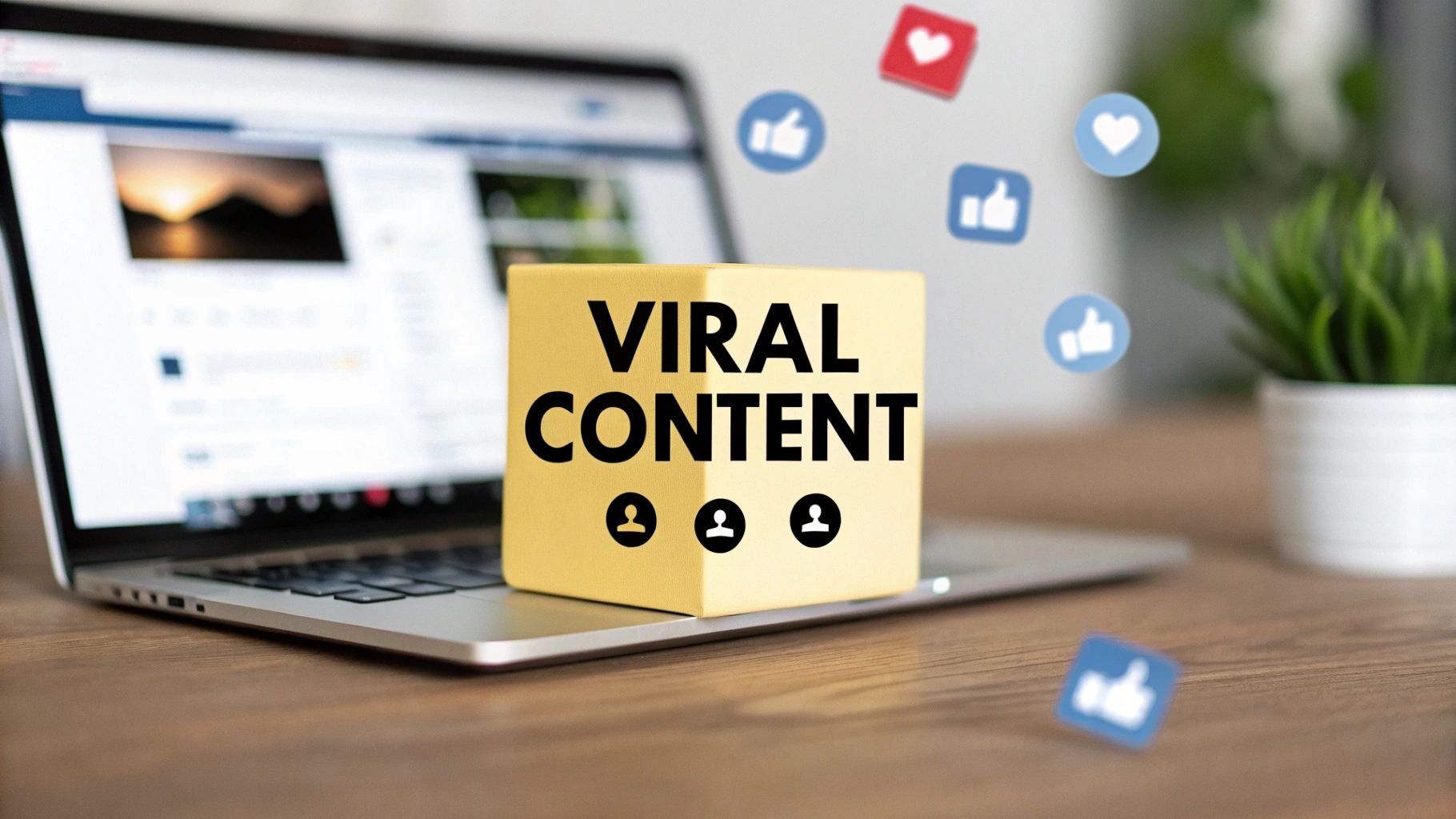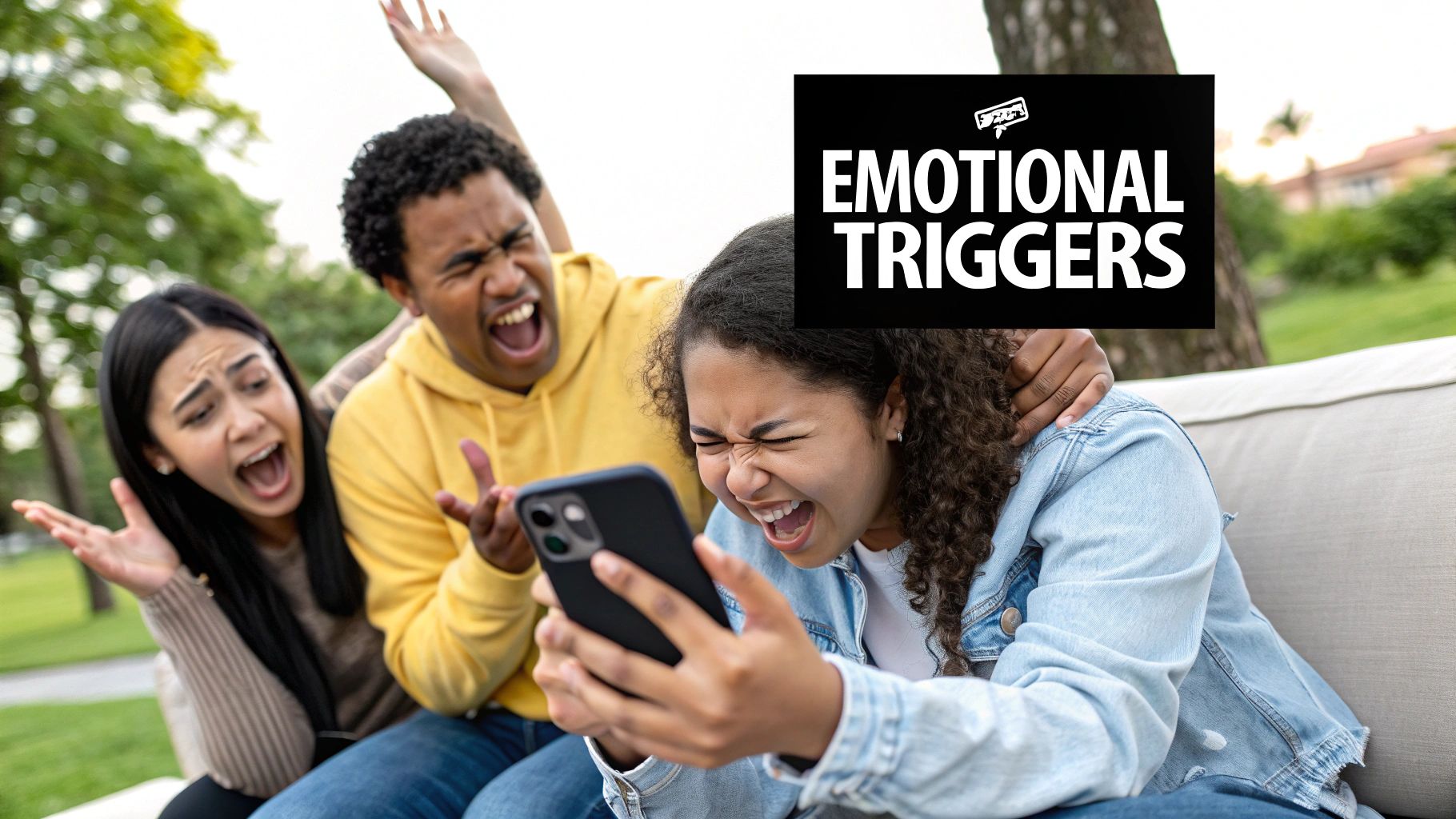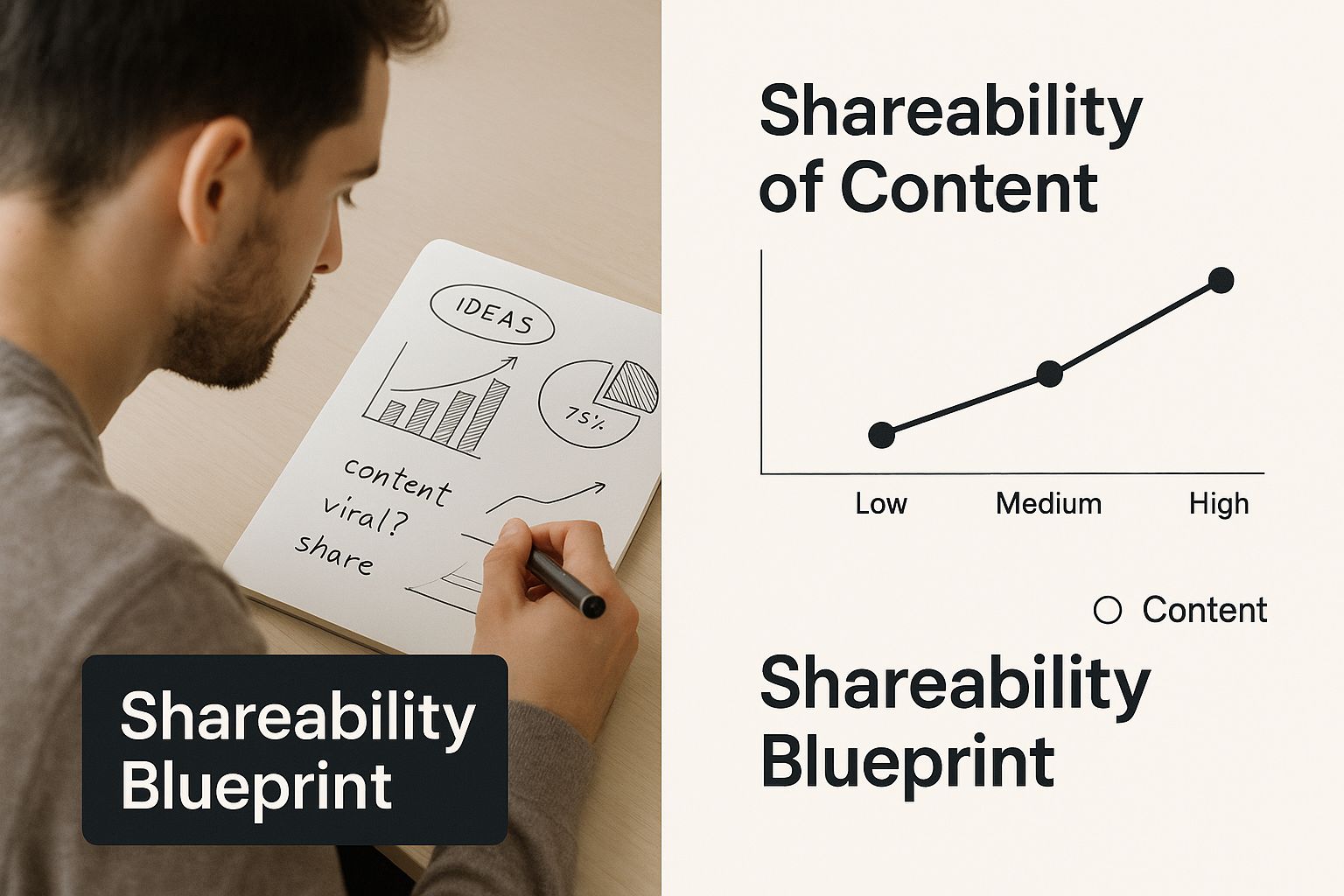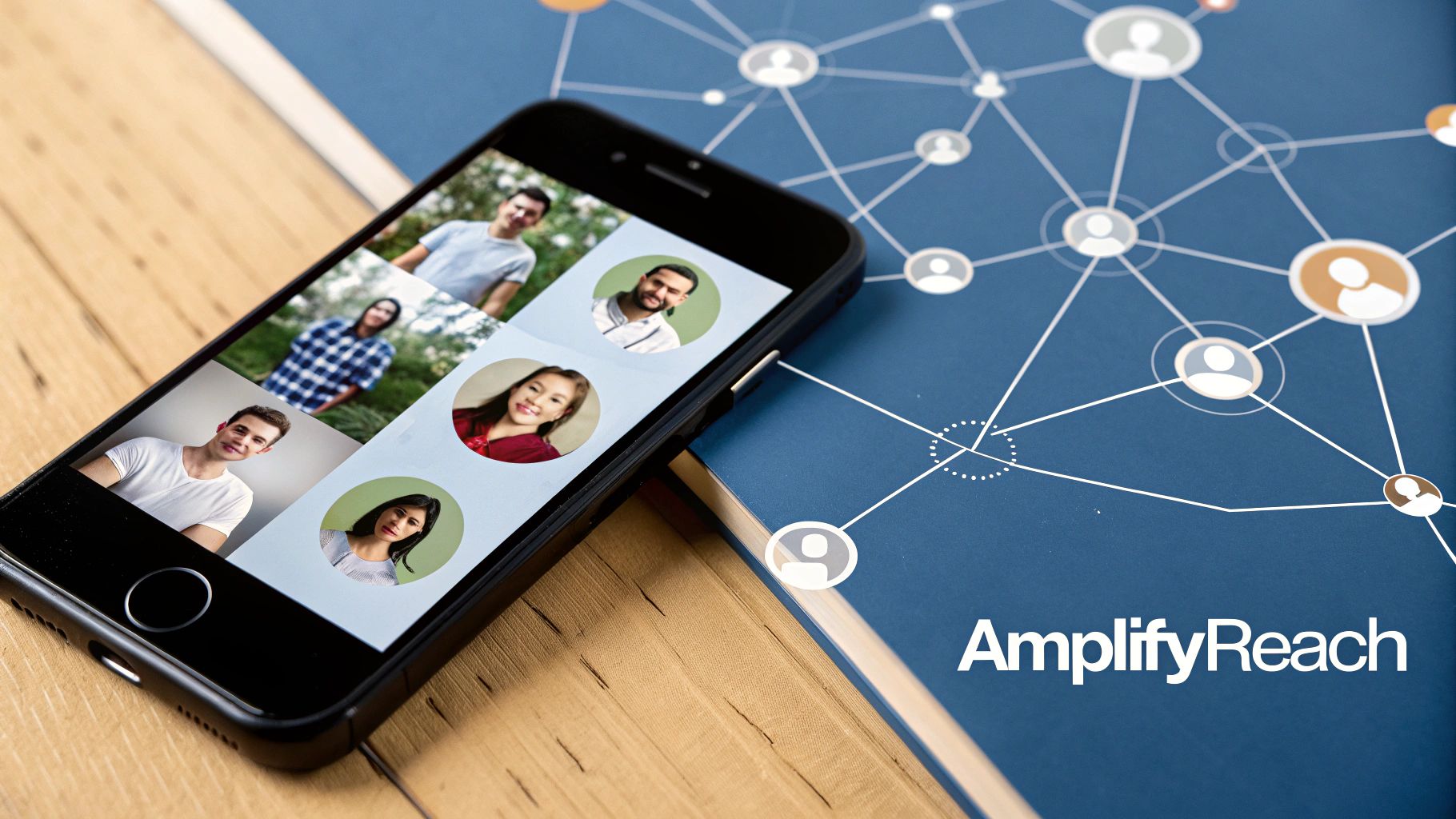
How to Create Viral Content: Tips to Boost Your Reach
Published on 2025-10-17
Ever wonder what makes a piece of content just explode? One minute it’s there, the next it’s everywhere. It's not magic, and it's rarely luck. It’s about understanding what makes a person stop scrolling, feel something, and then hit that share button almost without thinking.
You're trying to tap into a genuine human response. It’s about creating something that feels less like a post and more like a gift—a little nugget of wisdom, a good laugh, or a surprising fact they can't wait to pass on.
Decoding the DNA of Viral Content

So, why does one post get thousands of shares while another, equally well-written one, just sits there? The answer is almost always rooted in psychology. Viral content connects with us on a gut level, and it usually comes down to emotion.
But not just any emotion. We're talking about high-arousal emotions—the ones that get your blood pumping and make you want to do something. Think less about quiet contentment and more about feelings that demand a reaction:
- Awe: That feeling you get from a jaw-dropping scientific breakthrough or a video of something truly spectacular. It makes us feel connected to something bigger.
- Humor: A genuine, out-loud laugh is one of the most powerful connectors we have. If you can make someone laugh, they'll want to share that feeling with their friends.
- Surprise: An unexpected statistic, a myth completely busted, or a story with a twist. Our brains are wired to pay attention to the unexpected, and we love sharing those "aha!" moments.
- Anger: This one is a double-edged sword, but there's no denying its power. Content that taps into a shared frustration or a sense of injustice can spread like wildfire as people rally together.
The Power of Social Currency
Beyond a pure emotional jolt, people share things that make them look good. This is social currency. We're all curating our own personal brand online, and we share content that makes us look smarter, funnier, or more in-the-know.
When you create a post that breaks down a complex topic in a simple way or offers a truly unique insight, you’re handing your audience a piece of social currency. They can share it to look knowledgeable and helpful to their own network. It’s a way for them to add value and strengthen their own social standing.
We see this principle at play constantly on professional platforms. If you want to get more specific on how this works, our guide on crafting viral LinkedIn posts gets into the nitty-gritty of building this kind of value.
The ultimate goal is to create content that feels less like marketing and more like a shared experience. When someone shares your post, they should feel like they're offering a gift to their network, not just promoting a brand.
Storytelling as the Vehicle
Okay, so you have the emotion and the social currency. Now you need to package it. That package is storytelling.
Facts and data points are forgettable on their own. But wrap them in a story—a personal struggle, a customer’s surprising success, a behind-the-scenes look at a failure—and you create a real connection. Stories give context to your message and transform abstract concepts into something human and relatable. They are the engine that makes the impulse to share almost impossible to resist.
How to Engineer Content for Shareability
Knowing why people share is one thing, but actually getting them to do it? That's where the real work begins. You have to intentionally build shareability into every piece of content you create, from the first word of your headline right down to your final sign-off.
The best way to do this is by following a solid plan. A good social media content strategy playbook keeps you from just tossing content out there and hoping for the best. It makes you think like a publisher, carefully crafting posts designed to make a real splash.
And this matters more than ever. The market for digital content creation was worth a staggering $27.1 billion in 2023, and it’s projected to climb to $34.5 billion by 2025. That's a huge audience hungry for quality content.
Crafting a Compelling Narrative and Hook
Let's be blunt: your headline and first few lines are make-or-break. Their only job is to stop the endless scroll. So don't just state what your post is about—create a little mystery. Ask a bold question or drop a surprising statistic that makes someone think, "I have to know more."
Once you've grabbed their attention, your story needs to pull them in. A classic, effective structure is to introduce a common problem, dig into the pain points it causes, and then present your content as the perfect solution. This builds a natural tension that makes the final takeaway feel incredibly satisfying and worth sharing.
This infographic breaks down the essential ingredients for creating shareable content.

As you can see, it’s all about a powerful hook, an emotional connection, and real, practical value working in harmony.
Optimizing for Format and Readability
How your content looks is just as important as what it says. Certain formats are just naturally built for going viral.
Here are a few formats that consistently perform well:
- Interactive Quizzes: These are a goldmine for engagement. People love discovering something about themselves and can't wait to share their results.
- Data-Backed Infographics: They take complicated data and make it beautiful and easy to understand at a glance. They're perfect for professional platforms like LinkedIn.
- LinkedIn Carousels: These are fantastic for breaking down bigger ideas into digestible slides. The simple act of clicking through keeps people engaged, which the algorithm loves. If you need a jumpstart, our guide on AI carousels is a great resource.
The goal is simple: make your content incredibly easy to read and even easier to share. That means short paragraphs, bold text for emphasis, and lots of white space. If your post looks like a giant wall of text, you’ve already lost.
Why Video Is Your Strongest Bet for Going Viral
When you're trying to figure out how to make something go viral, all signs point to video. Great writing and eye-catching images still have their place, of course, but video plays in a league of its own. It’s a powerful mix of visuals, sound, and story that creates an emotional shortcut straight to your audience.
Think about it: video is the closest you can get to having a real conversation, just on a massive scale. People see your face and hear your voice, which builds trust and a sense of connection that plain text can't easily replicate. This human element is precisely what makes people hit the share button.
The numbers don't lie. A massive 91% of businesses are now using video in their marketing. And it's working. 87% of marketers credit video with directly boosting their lead generation, while the same percentage saw it drive a direct increase in sales. With 90% of video marketers on YouTube, it's clear where the audience is. You can dig into more of these stats to understand the full impact of video marketing.
Mastering Short-Form Video
Let's be honest, attention spans are shorter than ever. The explosion of short-form video has taught us to expect value almost instantly. If you want your content to have a fighting chance, you absolutely must hook viewers within the first three seconds.
Here are a few ways to grab that immediate attention:
- Lead with the good stuff. Don't bury your most surprising insight or valuable tip at the end. Open with it to make people curious to see how you got there.
- Add on-screen text. A lot of people scroll with their sound off. Big, bold text makes sure your message gets across, audio or not.
- Use quick cuts. Fast-paced editing keeps the energy up and stops thumbs from scrolling past your post.
Your goal isn't just to be seen; it's to be felt. Raw, authentic video often blows polished corporate productions out of the water because it feels genuine and relatable. Don't shy away from showing the real person behind the brand.
Building a Story Worth Sharing
Even a 30-second clip needs a story. The videos that get shared the most tend to follow a simple narrative: they introduce a problem we can all relate to, show a surprising solution, and wrap up with a satisfying takeaway. This simple arc makes your content feel complete and genuinely useful.
Imagine a marketing pro making a video that starts with, "Stop wasting money on ads that don't work." Right away, they’ve hooked anyone who’s ever felt that pain. The video could then quickly show an unconventional targeting trick and flash a screenshot of amazing results.
This formula is golden because it hits on two levels: it resonates emotionally by solving a common frustration, and it delivers practical value with a great tip. When you give someone that "aha!" moment, their first instinct is often to share that feeling. That’s how a viewer becomes your advocate, and that’s the real engine behind virality.
Smart Distribution to Amplify Your Reach

Here’s a hard truth: a brilliant piece of content is only half the battle. If you really want to see a post take off, you have to stop thinking like a creator and start thinking like a distributor.
Too many people pour their energy into crafting the perfect post, hit publish, and then just… wait. They cross their fingers and hope the algorithm smiles on them. That's not a strategy. The most compelling video or insightful article will simply vanish if it isn't actively pushed in front of the right people.
A smart distribution plan is the engine that powers virality. It's about getting your content into the hands of communities where it will spark conversation and resonate deeply.
Find Your Audience Where They Already Are
Before you even think about broad promotion, you need to go granular. Your target audience is already hanging out in specific corners of the internet. Your job is to find these digital "watering holes" and become part of the conversation, not just a drive-by promoter.
Think about places like:
- Niche Communities: Look for dedicated Slack channels, private forums, or specialized subreddits where your industry peers are active.
- LinkedIn Groups: Find the active, well-moderated groups where professionals are already discussing the exact problems your content solves.
- Industry Forums: Don’t write off old-school forums. Professionals still flock to them for deep, technical questions you won't find anywhere else.
The secret is to participate authentically long before you ever drop a link. Answer questions. Offer your insights. Build a little bit of a reputation first. When you finally share your work, people will see it as a valuable contribution from a community member, not just another piece of spam. Understanding how to share a video for maximum impact in these spaces, for example, is a skill that can give your content the initial traction it needs.
Don't just broadcast your content; integrate it. The goal is to start conversations where your audience is already talking. Strategic distribution isn't about shouting louder; it's about speaking in the right rooms.
The Power of Creator Collaborations
One of the fastest ways to get your content in front of a new audience is to partner with other creators. I’m not talking about paying for a generic shoutout, but finding genuine partners whose audience trusts their judgment. There's a reason creator marketing has become such a powerhouse.
Investment in this space has shot up by 143% since 2021, and an incredible 70% of brands say their highest-ROI campaigns come from working with creators. This is especially true for micro-influencers (those with 10k-100k followers). They often see an average engagement rate of 3.86%, which is way higher than their celebrity-level counterparts.
When you're looking for collaborators, prioritize alignment over audience size. A partner with a smaller, hyper-engaged following in your specific niche is infinitely more valuable than a macro-influencer with a broad, lukewarm audience.
Treat it like building a real professional relationship. Engage with their content first, offer them value, and then pitch a collaboration idea that benefits both of your audiences. This turns a one-off promotion into a network of allies who are all invested in each other's success, creating a powerful ripple effect for every post you publish.
Using Data to Fuel Your Next Viral Hit
Going viral once can feel like a lucky shot. But creating viral content consistently? That's not luck—it's a system. The key is to stop guessing what your audience wants and start listening to what their actions are telling you. Your own analytics are your most powerful creative tool, if you know how to use them.
Too many creators get hung up on vanity metrics like views or likes. They feel great, but they don't paint the full picture. To really understand what's resonating, you need to dig deeper into the numbers that actually signal genuine engagement and the potential for a post to take off.
Key Metrics That Signal Virality
Forget just counting views. Start looking for the data points that show how your content is spreading. These are the numbers that tell you if you're on the right track.
- Share Velocity: How fast are people sharing your post? A big spike in shares within the first few hours is a dead giveaway that you've struck a nerve.
- Audience Sentiment: What's the vibe in the comments? Are people tagging their colleagues, sparking debates, or adding their own stories? A handful of engaged, thoughtful comments are far more valuable than a hundred quiet likes.
- Click-Through Rate (CTR): If you've included a link in your post, a high CTR is a massive win. It means your content wasn't just interesting—it was compelling enough to make someone take action. That's a huge sign of trust.
The real magic isn't just counting what happened; it's understanding why it happened. Every metric is a breadcrumb leading you toward what your audience genuinely cares about.
Running Smart A/B Tests
The only way to get truly reliable data is to test your ideas methodically. A/B testing isn't just for marketers tweaking landing pages; it's an essential skill for any serious content creator. By changing just one thing at a time, you can figure out exactly what works.
For your next few posts, try isolating one variable and testing it.
- Test Your Hooks: Pit a question against a bold statement. For instance, you could try "Is cold outreach officially dead?" versus "Cold outreach is dead. Here's what works now."
- Test Your Visuals: Use two completely different images for the same core idea. Maybe a polished stock photo versus a quirky, AI-generated image. See which one actually stops the scroll.
- Test Your Distribution: Share the exact same post in two different LinkedIn groups at the same time. Which community gives it more of an initial boost?
This approach creates a powerful feedback loop. You stop just throwing content out there and start building a data-informed system that gets smarter with every single post you publish.
If you want to go deeper on this, our guide to a complete content performance analysis walks you through setting up this kind of process. When you learn to read the data correctly, you can see what resonates, refine your strategy, and make your next post that much more likely to succeed.
Your Burning Questions About Going Viral, Answered
Even with the best strategy in place, trying to make something go viral can feel like a bit of a black box. You're not alone if you still have questions.
Let's clear up some of the common uncertainties so you can fine-tune your approach and post with more confidence.
How Long Does It Take for Content to Go Viral?
There’s no set timeline, unfortunately. Some posts catch fire and explode within hours. Others simmer for a few days, slowly building momentum before they take off. A lot of it comes down to getting that initial boost from the right audience at just the right moment.
That said, the first 24-48 hours are your best tell. If you’re seeing a ton of engagement and a spike in shares right out of the gate, you might have a hit on your hands. This is why having a distribution plan ready is so critical—you need to be prepared to add fuel to the fire as soon as you see a spark.
Can Content from a 'Boring' B2B Industry Go Viral?
100% yes. You just have to shift your definition of "viral." Forget millions of views from random people. For B2B, going viral means reaching the right few thousand people—the ones who can actually move the needle for your business.
B2B content that pops off in its niche usually does one of these things incredibly well:
- It solves a very specific, nagging problem that everyone in the industry complains about but no one has addressed clearly.
- It reveals surprising data or a unique insight that forces professionals to stop and rethink their own assumptions.
- It leans into humor and inside jokes that only people in that field will truly get.
Don't underestimate the power of a niche audience. A single share from a well-respected industry leader is often worth more than a thousand shares from the general public.
What Are the Biggest Mistakes to Avoid?
Sometimes, knowing what not to do is just as important as knowing what to do. I see a lot of people make the same few mistakes over and over again. If you can sidestep these, you’ll be way ahead of the curve.
The absolute biggest mistake is creating content with the sole purpose of going viral. People can smell clickbait and inauthenticity from a mile away, and it's a huge turn-off. You have to lead with genuine value.
Another killer is simply hitting "publish" and hoping for the best. Forgetting about distribution is like planning a party but not sending out any invitations. You have to actively get your content in front of people. Finally, don't ignore your analytics. Every single post—whether it soars or flops—is a learning opportunity.
Ready to create scroll-stopping LinkedIn posts that drive real engagement? Let autoghostwriter help you craft high-quality content with advanced AI, proven templates, and a library of inspiration. Start creating better content today.